“Evolution” is a word that engenders considerable controversy – if not outright purple-faced fights – in this country; and its place in the public-school science curriculum has never been secure.
It’s time we did better.
Evolution is the fundamental underlying theory of all the life sciences. No science education is complete – or, frankly, possible – without it.
Table of Contents
EVOLUTION IN THE CLASSROOM: How’s Your State Doing?
| From NPR, Teaching Evolution: A State-by-State Debate describes how various states are dealing with the evolution. Most of them, poorly. | |
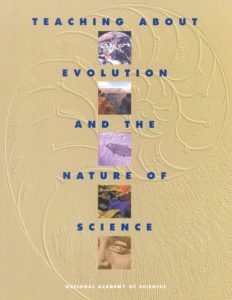
|
From the National Academy of Sciences, the 150-page Teaching About Evolution and the Nature of Science (National Academies Press, 1998) is crammed with illustrations, explanations, teaching suggestions, and resources for kids in grades 5-12. Of particular interest are the sections on “Why Teach Evolution,” which lists many convincing reasons; “Evolution and the Nature of Science,” which clearly explains the crucial theory and demonstrates its relevance to a wide range of scientific disciplines; and “Frequently Asked Questions About Evolution and the Nature of Science” (with answers). Also see Evolution in Hawaii: A Supplement to Teaching About Evolution and the Nature of Science (National Academies Press, 2004) and by Lee Meadows, The Missing Link: An Inquiry Approach for Teaching All Students About Evolution (Heinemann, 2009). |
ALL ABOUT EVOLUTION
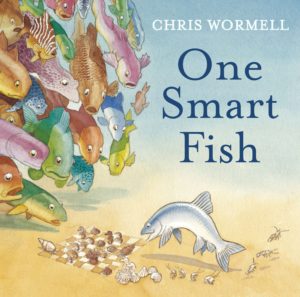
|
Christopher Wormell’s One Smart Fish (Red Fox Picture Books, 2011) is the story of a highly intelligent little fish – he sings, dances, and plays chess (with himself) – who is curious about life on land. Cleverly, he invents a set of feet and clambers out of the water. He finds the land barren and lonely, so he returns to the sea – but then, a few million years later, other fish follow in his footsteps. Eventually from those first slithering fish, lizards evolve – and from them a marvelous host of land animals. A rare introduction to evolution for ages 3-6. |
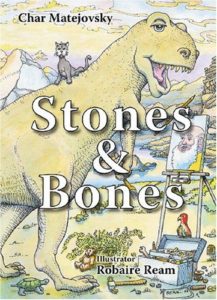
|
Char Matejovsky’s picture-book Stones & Bones (Polebridge Press, 2007) covers evolution in seventeen rhyming verses. (“About sixty million years ago/No, make that sixty five/With the Cenozoic Age/The age of mammals would arrive.”) Detailed illustrations provide fun Where’s-Waldo-like details – a row of books in the crowded library lists geologic eras and periods in order; fossils hang on the walls; Darwin’s tortoise crawls across the floor. Included with the book is a CD on which the verses are set to music. For ages 4-9. |
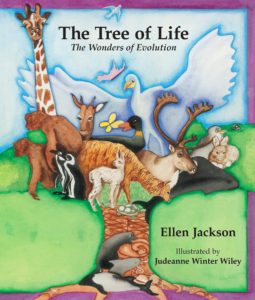
|
Ellen Jackson’s The Tree of Life (Prometheus Books, 2004) traces the history of life from its beginnings as single cells in the oceans to multicellular organisms, fish, amphibians, reptiles, dinosaurs, insects, birds, mammals, and the first humans. A simple overview of evolution for ages 4-9. |
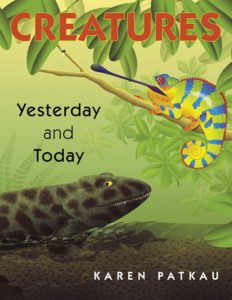
|
Karen Patkau’s Creatures Yesterday and Today (Tundra Books, 2012) pairs prehistoric animals with their (related, but startlingly different) modern descendants, each of which – in the first person – tells a bit about themselves. Included is a comprehensive array of animals – reptiles, birds, amphibians, fish, insects, arachnids, mollusks, mammals, crustaceans, sea jellies. The first pair, for example, is the Jurassic Diplodocus (“I was a giant plant-eating dinosaur…”) and its distant descendant, the skylark (“Like a therapod of long ago, I have a wishbone, scaly feet, and hard-shelled eggs.”). For ages 4-8. |
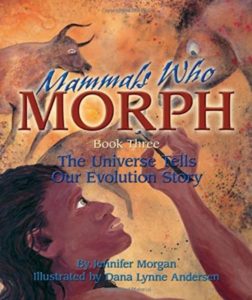
|
By Jennifer Morgan, Mammals Who Morph (Dawn Publications, 2006) is the third of a trilogy in which the Universe itself narrates its story, beginning with Born With a Bang (2002) and From Lava to Life (2003). Subtitled “The Universe Tells Our Evolution Story,” the book traces the evolution of the tiny mammals who survived the extinction of the dinosaurs into their many and varied descendants. For ages 5-8. |
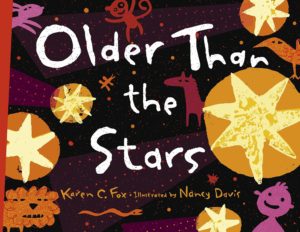
|
In Karen Fox’s Older Than the Stars (Charlesbridge Publishing, 2011), a mix of splashy illustrations, catchy rhymes, and straightforward prose show readers that every part of human beings was created billions of years ago in the Big Bang. The iron in our blood may have come from an ancient volcano; the oxygen in our lungs may have been breathed by dinosaurs. A compelling overview of Big Bang cosmology, planetary formation, and evolution for ages 5-9. |
|
Joanna Cole’s Evolution (HarperTrophy, 1989) is a simple picture-book explanation of evolutionary theory from both a biological and a geological perspective, with charming drawings and diagrams by Aliki. It’s very well done – and it’s out of print, for reasons that escape me. Luckily, however, it’s available from libraries and, inexpensively, from used-book suppliers. For ages 5-9. |
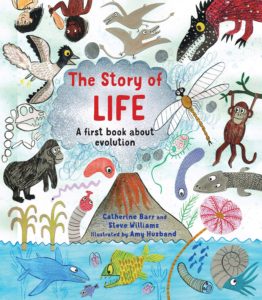
|
By Catherine Barr and Steve Williams, The Story of Life (Frances Lincoln Children’s Books, 2015) is a first introduction to evolution, from the first cells through jellyfish, worms, fish, land animals, dinosaurs, and on. For ages 6-9. |
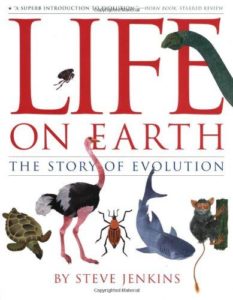 |
By Steve Jenkins, Life on Earth: The Story of Evolution (Houghton Mifflin Harcourt, 2002) is a remarkable illustrated history of all the millions who have lived on earth, with dozens of wonderful color illustrations and an annotated timeline. For ages 7-10. |
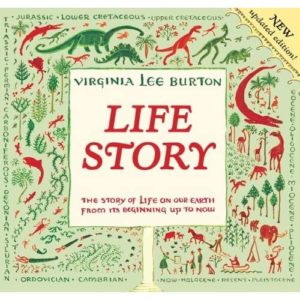
|
Virginia Lee Burton’s Life Story (Sandpiper, 2009) is a delightful picture-book history of life on earth, presented as a play in five acts – namely the Paleozoic, Mesozoic, and Cenozoic Eras, Recent Life, and Most Recent Life. The book begins with an introductory “Cast of Characters,” listing “Leading Animals” and “Leading Plants” in order of appearance; the curtain rises on the beginnings of the Milky Way Galaxy. For ages 7-10. |
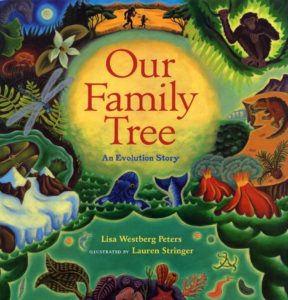
|
By Lisa Westberg Peters, Our Family Tree: An Evolution Story (Harcourt Children’s Books, 2003) is a poetic picture-book account of evolution, from the beginning of life on earth nearly four billion years ago to the emergence of human beings from primate ancestors. (“All of us,” Peters begins, “are part of an old, old family.”) Included are helpful notes and an illustrated timeline. For ages 7-10. |
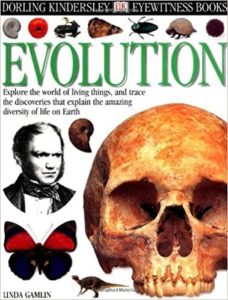
|
Linda Gamlin’s Evolution in the Eyewitness Series (Dorling Kindersley, 2009) contains 64 pages of visually appealing double-page spreads, each – through color photographs, drawings, and explanatory picture captions – detailing a different evolutionary topic. Examples include “Fossil evidence,” “The age of the Earth,” and “How new species are formed.” For ages 7-12. |
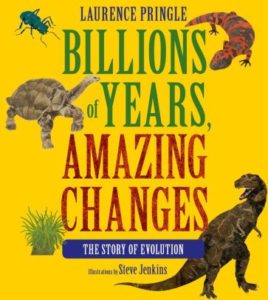
|
Laurence Pringle’s Billions of Years, Amazing Changes (Boyds Mills Press, 2011) is a 112-page survey of evolution, illustrated with wonderful color photographs and drawings. Pringle discusses the evidence for evolution, beginning with geology and the fossil record, then moving on to Darwin’s discoveries, natural selection, genetics, and biogeography. For ages 8 and up. |
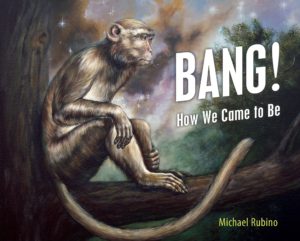
|
Michael Rubino’s 64-page Bang! How We Came to Be (Prometheus Books, 2011) is a beautifully illustrated progression through time in a series of double-page spreads, from the Big Bang to the formation of the planets to the evolution of life on Earth. For ages 8 and up. |
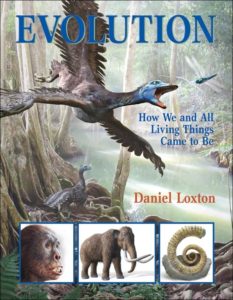
|
Daniel Loxton’s award-winning 56-page Evolution: How We and All Living Things Came to Be (Kids Can Press, 2010) – initially, disgracefully, shunned by US publishers as “too controversial” – covers the basics of natural selection and evolutionary theory, evolution as relevant to our daily lives (for example, why do we need a new flu vaccine each year?), and the various objections commonly posed by opponents of evolution, using a combination of interesting, accessible text and catchy Q&A boxes. Sample questions include “What is a species?” “Can we ever see evolution happening?” and “How could evolution produce something as complicated as my eyes?” For ages 8-13. |
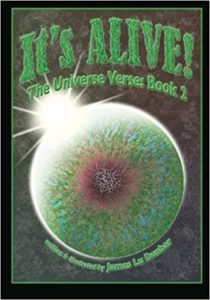
|
James Lu Dunbar’s It’s Alive (CreateSpace Independent Publishing, 2011), the second of a three-book series, is a terrific 42-page graphic overview of the formation of the planets and the origin of life on Earth, with witty illustrations and a clever rhyming text. Other titles are Bang!, a graphic rendition of the creation of the universe, and the upcoming Great Apes! Available as a free ebook from Dunbar’s website, The Universe Verse or in paperback format from Amazon. For ages 9 and up. |
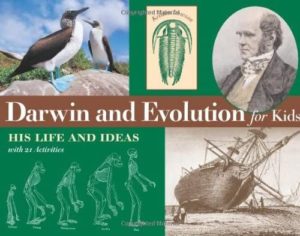
|
Kristan Lawson’s Darwin and Evolution for Kids (Chicago Review Press, 2003), pairs the history and science of the theory of evolution with Charles Darwin’s life story. The book covers Darwin’s beetle-collecting school years; his voyage as a naturalist on board the Beagle; the development of his famous theory; and the publication of Origin of Species. A further chapter explains the theory in more detail, and includes a short but useful question-and-answer section. The book is illustrated with period prints, photographs, diagrams, and maps, and includes assorted interesting fact boxes (an account of the Galapagos Islands, a brief biography of Alfred Russel Wallace, the story of the peppered moth, a timeline of evolutionary thinkers). It also includes 21 hands-on activities – for example, kids can bake a batch of Shrewsbury cakes (the food of the Darwinian era); learn to tie a bowline knot (think sailors on the Beagle); build a model of geological strata; make plaster-of-Paris fossils; and play a life-simulation game designed to demonstrate the effects of natural selection on an imaginary population of Dum-Dum birds. For ages 9-13. |
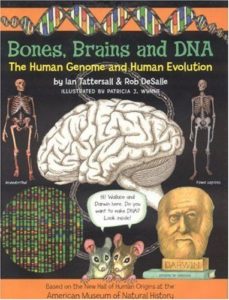
|
By anthropologist Ian Tattersall and molecular biologist Rob De Salle, the 40-page Bones, Brains, and DNA: The Human Genome and Human Evolution (Bunker Hill Publishing, 2007) – based on the American Museum of Natural History’s Hall of Human Origins exhibits – explores the cutting-edge science used to explore the history of human evolution, with the help of a pair of chatty museum mice, Wallace and Darwin. Illustrated with photos, diagrams, charts, and cartoon mice. For ages 7-10. |
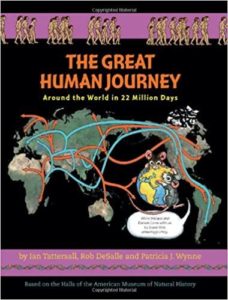
|
Ian Tattersall and Rob DeSalle’s The Great Human Journey: Around the World in 22 Million Days (Bunker Hill, 2013) traces human evolution from the first hominids to human migration across the planet, with Wallace and Darwin, the Museum Mice from the American Museum of Natural History. For ages 8-12. |
| Visit the AMNH Hall of Human Origins online. At the website are highlights of the exhibits, printable resources for educators, book lists for both children and adults, informational articles, interactive puzzles, and instructions for many hands-on activities. For example, kids make a DNA model and a chimp genome bracelet, and make and excavate “fossils” using chicken bones and plaster of Paris. | |
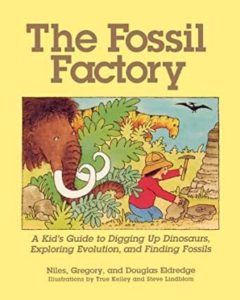
|
By Niles, Gregory, and Douglas Eldredge, the 112-page The Fossil Factory (Roberts Rinehart, 2002) is an activity-packed “Kid’s Guide to Digging Up Dinosaurs, Exploring Evolution, and Finding Fossils.” The book covers fossil formation, excavation, and analysis, and the evolution of life on Earth. Among the topics covered are plate tectonics, carbon dating, rock layers and the fossil record, trilobites, the oldest trees, the extinction of the dinosaurs, Lucy and early hominids, and “the first Americans.” For ages 7-12. |
|
|
By John Pojeta and Dale A. Springer, Evolution and the Fossil Record is a color-illustrated, 35-page downloadable booklet from the American Geological Institute and the Paleontological Society. Included are timelines, diagrams, great photographs of fossils, and nicely presented information for ages 12 and up. |
| From the science journal Nature, 15 Evolutionary Gems is a collection of short essays on key concepts in evolutionary thinking, categorized under the Fossil Record, Habitats, and Molecular Processes. Sample titles include “Land-living ancestors of whales,” “The origin of feathers,” “The evolutionary history of teeth,” “Natural selection in lizards,” and “Darwin’s Galapagos finches.” | |
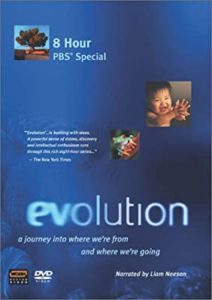 |
Evolution is the website designed to accompany the excellent 7-part PBS series of the same name. Included are background information and activities related to each of the episodes: “Darwin’s Dangerous Idea,” “Great Transformations,” “Extinction!,” “The Evolutionary Arms Race,” “Why Sex?,” “The Mind’s Big Bang,” and “What About God?” Also at the site is an Evolution Library of resources for teachers and students, including online lessons and video presentations. |
| The Evolution Library’s Evolving Ideas series is a collection of seven short student-targeted videos, among them “Isn’t Evolution Just a Theory?,” “Who Was Charles Darwin?,” “How Do We Know Evolution Happens?,” and “Why Does Evolution Matter Now?” For accompanying lesson plans with activities, see Online Lessons: Learning Evolution. | |
| Explore the tree of life with NOVA’s Evolution Lab. | |
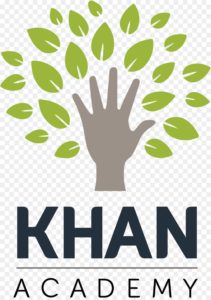 |
From Khan Academy, Evolution and Natural Selection is a series of free lectures – delivered with the help of blackboard drawings – that clearly explains the crucial concepts for middle-school-level students and up. Titles are “Introduction to Evolution and Natural Selection” “Intelligent Design and Evolution,” “Evolution Clarification,” “Natural Selection and the Owl Butterfly,” “DNA,” and “Variation in a Species.” |
| The TalkOrigins Archive is a collection of articles, essays, and discussions about biological and physical origins. Click on “Evolution,” for example, for the full text of Darwin’s On the Origin of Species and essays on such topics as genetic drift, punctuated equilibria, fossil hominids, Piltdown man, and the evolution of color vision. | |
| From the University of California Museum of Paleontology, Understanding Evolution includes Evolution 101, a free online course on the theory and mechanisms of evolution, as well as resources for teachers (K-college), an excellent and enormous online resource library, and accounts of evolution in the news. | |
| Through MIT Open Courseware, course materials from MIT classes are made available online for the general public. A subset of the website, Guide for Teachers, lists materials most useful for high-school-level students. See, for example, Fundamentals of Biology, which includes video lectures on evolutionary theory. |
